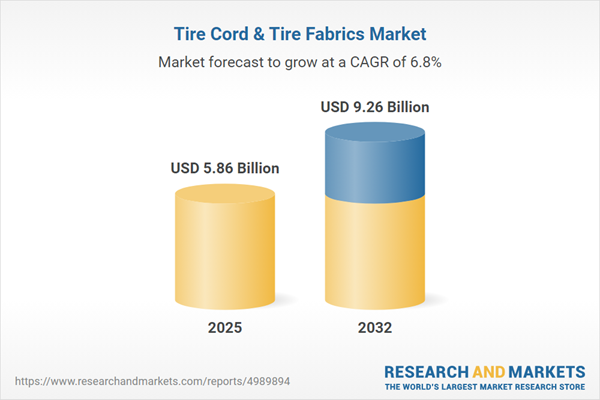Speak directly to the analyst to clarify any post sales queries you may have.
The tire cord and tire fabrics market is undergoing rapid transformation as senior executives adapt their sourcing strategies in response to shifts in automotive technology, sustainability mandates, and a dynamic regulatory environment.
Market Snapshot: Tire Cord & Tire Fabrics Market
In 2024, the global tire cord and tire fabrics market reached a value of USD 5.48 billion, cementing its role as a critical element in automotive reinforcement. Projections indicate ongoing expansion to USD 5.86 billion in 2025 and USD 9.26 billion by 2032, with a compound annual growth rate (CAGR) of 6.76%. This trajectory is fueled by escalating commitments to advanced material technologies, increased adoption in electric and autonomous vehicles, and comprehensive regulatory oversight. Senior executives in the sector are actively recalibrating procurement models, upgrading technical standards, and navigating complex, international supply chains to stay competitive.
Scope & Segmentation: Tire Cord and Tire Fabrics Market
To support data-driven procurement and mitigate supply chain volatility, decision-makers require clarity on material types, application areas, and distribution practices within the tire cord and tire fabrics market. Segmentation empowers organizations to tailor responses to an increasingly intricate operating environment.
- Material: Covers aramid for heat resistance, nylon for strength, polyester and rayon for flexibility—enabling targeted solutions aligned with durability and compliance needs.
- Yarn Type: Includes twist yarn for consistent manufacturing results and wrapped yarn to enhance tire performance, chosen based on specific vehicle requirements and operational demands.
- Fabric Type: Single ply and multi ply configurations provide resilience and adaptability, designed to optimize both new and replacement tire applications.
- Application: Spans commercial vehicles, passenger cars, two-wheelers, and off-road equipment, ensuring relevance in each automotive sector’s evolving landscape.
- End Use: Differentiates original equipment manufacturing (OEM) from aftermarket supply, necessitating distinct sourcing and inventory approaches.
- Distribution Channel: Addresses both digital and traditional channels, influencing procurement efficiency and responsiveness.
- Region: Includes Americas, Europe, Middle East & Africa, and Asia-Pacific—each affected by distinct regulations, production trends, and sourcing structures.
- Notable Companies: Kordsa Teknoloji Sanayi ve Ticaret A.Ş., Teijin Limited, Hyosung Corporation, Kolon Industries, Asahi Kasei Corporation, Invista Inc., Indorama Ventures, Toyobo Co., Ltd., Lanxess AG, and Sinopec Yizheng Chemical Fibre Co., Ltd drive innovation and strategic growth.
- Emerging Technologies: Nanotechnology and digital weaving offer expanded customization and improved durability, enabling preparedness for future product applications.
- Regional Dynamics: Regulatory changes in Europe and increased production in Asia-Pacific require adaptive procurement and compliance frameworks for global operators.
Key Takeaways for Senior Decision-Makers
- Investing in innovative materials aids leadership in aligning procurement with sustainability goals and regulatory expectations.
- Cooperation among suppliers, OEMs, and tire manufacturers accelerates product development and adoption as electric and automated vehicles reshape demand.
- Adapting procurement strategies ensures operational agility and helps mitigate regulatory or technology-driven disruption.
- Comprehensive risk management protects supply continuity and organizational resilience against unpredictable market or geopolitical events.
- Incorporating digital procurement and process automation supports efficient, timely responses to changing market conditions and fosters better-informed decision-making.
Tariff Impact on Competitive Dynamics
Anticipated U.S. tariffs scheduled for 2025 are prompting companies in the tire cord and tire fabrics sector to examine alternative sourcing channels, modify manufacturing strategies, and assess cost structures. This adjustment landscape emphasizes the strategic importance of compliance adaptation and sophisticated risk mitigation, enabling organizations to address international pricing pressures while maintaining effective procurement across borders.
Methodology & Data Sources
This analysis was developed using insights from fiber technology specialists, automotive sector analysts, and textile researchers. A combination of technical evaluation, patent analysis, and scenario modeling ensures actionable, tailored intelligence for executive planning in the tire cord and tire fabrics sector.
Why This Report Matters
- Prepares executives for regulatory change and reinforces robust, flexible supply chains through data-backed analysis of tire cord and tire fabrics sector developments.
- Supports resource allocation and procurement planning with current trends and competitive benchmarks, contributing to sustainable advantage.
- Outlines best practices for responsive sourcing, helping organizations excel in dynamic international supply environments.
Conclusion
This report delivers actionable insights for enhancing procurement strategy, supporting risk mitigation, and empowering senior decision-makers as the global tire cord and tire fabrics market evolves.
Additional Product Information:
- Purchase of this report includes 1 year online access with quarterly updates.
- This report can be updated on request. Please contact our Customer Experience team using the Ask a Question widget on our website.
Table of Contents
3. Executive Summary
4. Market Overview
7. Cumulative Impact of Artificial Intelligence 2025
Companies Mentioned
The companies profiled in this Tire Cord & Tire Fabrics market report include:- Kordsa Teknoloji Sanayi ve Ticaret A.Ş.
- Teijin Limited
- Hyosung Corporation
- Kolon Industries, Inc.
- Asahi Kasei Corporation
- Invista Inc.
- Indorama Ventures Public Company Limited
- Toyobo Co., Ltd.
- Lanxess AG
- Sinopec Yizheng Chemical Fibre Co., Ltd.
Table Information
| Report Attribute | Details |
|---|---|
| No. of Pages | 198 |
| Published | October 2025 |
| Forecast Period | 2025 - 2032 |
| Estimated Market Value ( USD | $ 5.86 Billion |
| Forecasted Market Value ( USD | $ 9.26 Billion |
| Compound Annual Growth Rate | 6.7% |
| Regions Covered | Global |
| No. of Companies Mentioned | 11 |









